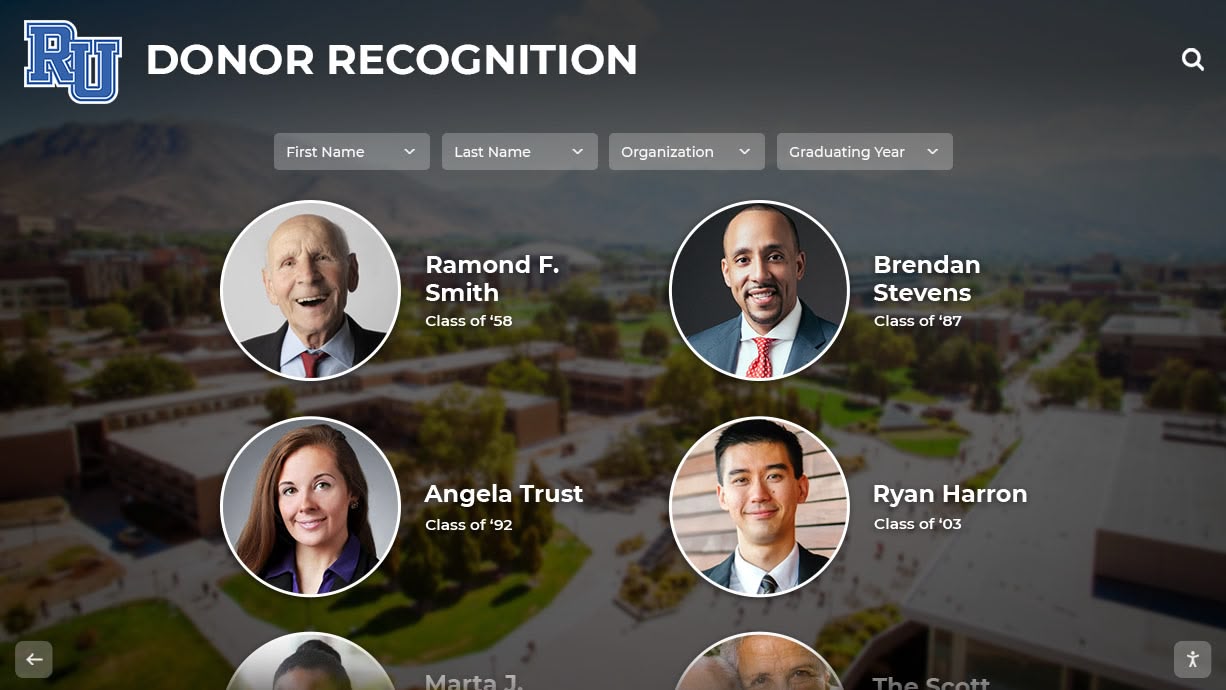Universities and colleges seeking to strengthen alumni relationships and inspire sustained philanthropic giving face a fundamental challenge: how to meaningfully recognize thousands of supporters while creating recognition experiences that inspire continued and increased giving. At the heart of successful higher education advancement strategies stands the collegiate donor wall—a dedicated space celebrating contributors whose financial support advances institutional missions while creating powerful social proof that motivates future generations of giving.
Whether you’re a major research university honoring transformational seven-figure commitments, a liberal arts college recognizing loyal annual fund supporters, or a community college celebrating first-generation donors who give back after achieving success, an effectively designed collegiate donor wall serves multiple strategic purposes simultaneously. It expresses institutional gratitude for financial support, inspires additional giving through visible social proof of philanthropic participation, strengthens emotional bonds between alumni and their alma mater, creates aspirational pathways for current students witnessing philanthropy’s impact on campus resources, and establishes clear giving level expectations through tiered recognition structures that guide donor behavior.
This comprehensive guide explores everything advancement professionals need to know about collegiate donor walls—from understanding their strategic foundations and psychological drivers through planning considerations, design principles, implementation approaches, content strategies, and measuring fundraising impact. Whether creating your first recognition program or modernizing existing approaches to leverage contemporary technology, this resource provides actionable frameworks based on proven results from successful installations across diverse higher education contexts.
Understanding Collegiate Donor Walls in Higher Education
A collegiate donor wall represents a dedicated recognition space—physical, digital, or hybrid—where universities and colleges permanently celebrate alumni, parents, faculty, staff, corporations, and community supporters who provide financial resources advancing institutional missions. Unlike temporary acknowledgment through annual reports or event programs, donor walls create lasting visibility that honors contributors across years or decades, establishing enduring symbols of gratitude and philanthropic tradition within campus environments.
The Unique Context of Collegiate Donor Recognition
Higher education donor recognition operates within distinct contexts differentiating it from recognition in healthcare, cultural institutions, or nonprofit organizations.
Multi-Generational Alumni Communities: Universities cultivate relationships spanning entire lifetimes and across generations. Unlike single-transaction donors supporting specific causes, alumni maintain lifelong connections to institutions that shaped their personal and professional trajectories. Collegiate donor walls tap into this enduring relationship, positioning giving as natural extension of ongoing institutional affiliation rather than one-time charitable acts.
This multi-generational dimension creates particularly powerful recognition opportunities. Parents who attended see their names alongside their children’s contributions. Siblings from different graduating classes appear together. Multi-generational families spanning three, four, or even five decades of institutional connection demonstrate philanthropic traditions passing through family lines.
Peer Influence Within Class Communities: Alumni organize naturally into cohort communities based on graduating classes, creating strong peer influence dynamics. When classmates observe fellow graduates giving at specific levels, powerful social norming occurs. Recognition displaying class year information leverages these peer relationships, creating competitive motivation during reunion campaigns and class giving challenges that drive participation and upgrade behavior.
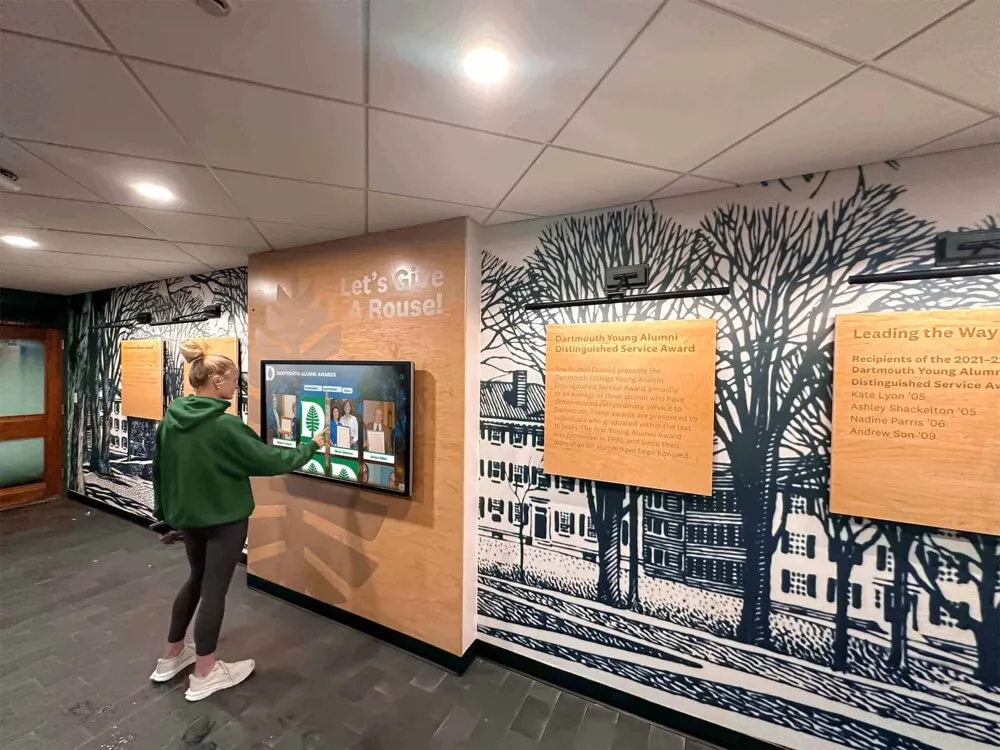
Academic Program and Athletic Affiliation: College experiences connect donors to specific academic programs, departments, schools, athletic teams, student organizations, and campus locations. Effective collegiate donor walls incorporate these affiliation dimensions, allowing recognition to celebrate both institutional support and designated giving to particular programs. Alumni who competed on tennis teams, majored in engineering, participated in student government, or lived in specific residence halls feel stronger connections when recognition acknowledges these specific affiliations alongside their financial contributions.
Current Student Inspiration: Collegiate environments uniquely position donor recognition where current students regularly encounter it—in academic buildings, student centers, libraries, athletic facilities, and residence halls. This constant exposure creates powerful modeling effects. Students witnessing distinguished alumni giving back internalize expectations that successful graduates support their alma mater financially. This socialization process establishes giving patterns before alumni ever receive their first solicitation, dramatically improving lifetime donor acquisition and retention rates.
Strategic Advantages for University Advancement
Collegiate donor walls deliver measurable benefits across multiple institutional advancement priorities beyond simple contribution acknowledgment.
Alumni Donor Retention Improvements: Small improvements in donor retention rates create enormous differences in lifetime donor value through compound effects over multiple giving cycles. Universities implementing comprehensive recognition programs report retention rate improvements of 15-30 percentage points stemming from immediate satisfaction through timely recognition, ongoing engagement via visible displays creating pride in institutional association, deepened emotional connections through storytelling about impact, and strengthened sense of belonging to communities of supporters.
Consider two universities with identical 500 new alumni donors giving $250 annually. University A retains 35% of donors year-over-year while University B retains 55% through strategic recognition. After five years, University A has 23 active donors contributing $5,750 annually while University B maintains 228 donors generating $57,000 annually—nearly 10x annual revenue from identical starting points. Over ten years, cumulative revenue gaps exceed $1.5 million simply due to improved retention from the same initial donor pool.
Major Gift Cultivation Tools: Collegiate donor walls serve as powerful cultivation tools throughout major gift conversations. Development officers strategically use recognition displays during campus tours with prospects, showing exactly how institutions celebrate significant contributions and demonstrating the visibility donors receive. When prospects considering transformational gifts observe impressive displays celebrating previous generations’ philanthropy, they can visualize their own names and stories appearing similarly, making legacy conversations tangible rather than theoretical.
Research from advancement consulting organizations consistently indicates universities experience 25-40% increases in gifts over $25,000 in the three years following comprehensive recognition program launches, demonstrating direct connections between visible, meaningful recognition and major gift commitments.
Reunion Campaign Acceleration: Milestone reunions—5th, 10th, 25th, 50th anniversaries—provide exceptional fundraising opportunities when coupled with recognition programs. Collegiate donor walls featuring class-based organization enable reunion campaign strategies where returning alumni see their class’s cumulative giving totals, participation rates, and distinguished donors, creating competitive dynamics that drive reunion year fundraising results. Universities implementing class-focused recognition report 30-45% improvements in reunion year campaign results compared to institutions without visible class recognition programs.
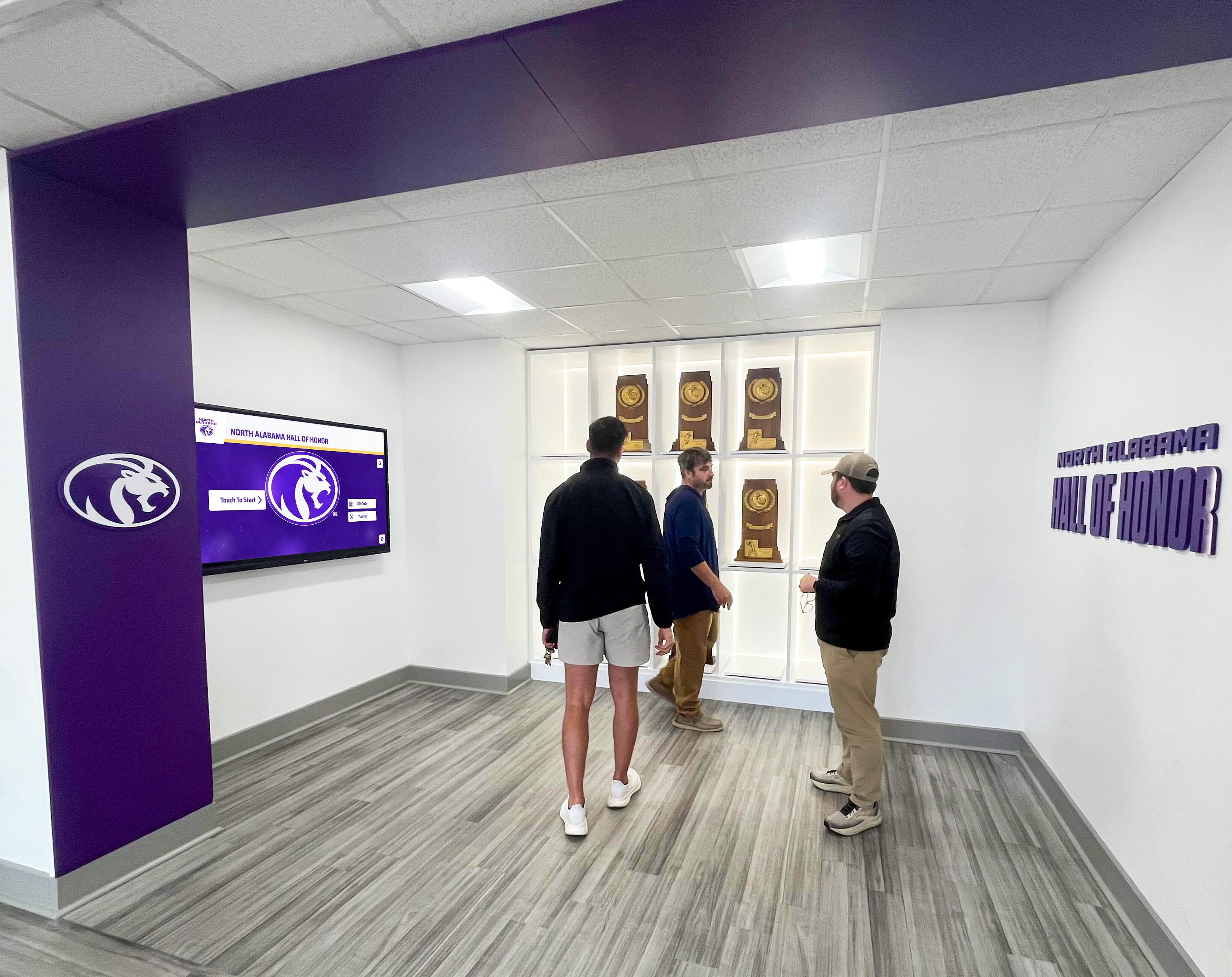
The Psychology Behind Collegiate Recognition-Driven Giving
Understanding why recognition influences alumni giving behavior helps universities design programs maximizing fundraising effectiveness while honoring supporters meaningfully.
Institutional Gratitude and Reciprocity
Alumni who feel their education provided significant life advantages—career opportunities, intellectual development, social connections, personal growth—experience gratitude motivating reciprocal support. When universities thoughtfully acknowledge this reciprocal giving through meaningful recognition, they validate donors’ generous impulses while reinforcing positive associations with giving acts themselves.
This emotional satisfaction makes alumni significantly more likely to contribute again, creating virtuous cycles where recognition strengthens relationships, deepening commitment and inspiring continued philanthropy. Universities effectively communicating “your gift made a difference and we deeply appreciate it” through visible, lasting recognition generate dramatically higher retention rates than institutions sending perfunctory acknowledgment letters before moving on to next solicitation cycles.
Legacy and Symbolic Immortality in Academic Contexts
Humans possess fundamental desires to create lasting impact extending beyond their lifetimes. Psychologists describe this as “symbolic immortality”—the drive to leave meaningful marks that endure after death. Collegiate donor recognition taps directly into this powerful motivation within contexts deeply connected to personal identity formation.
Permanent Campus Presence: For many alumni, college years represented formative periods when identities, values, careers, and life partnerships formed. Having one’s name permanently displayed on campus where these transformative experiences occurred provides profound satisfaction. Unlike recognition in organizations with weaker personal connections, collegiate donor walls honor contributors in spaces central to their life narratives.
Multi-Generational Family Academic Traditions: Many families maintain multi-generational university traditions where parents, children, grandchildren, and extended family members attend the same institutions. Recognition celebrating family giving legacies taps into powerful identity dimensions around family values, educational commitments, and traditions passed through generations. Parents increasing giving to appear alongside children already recognized, or children contributing to join parents and grandparents, represents common behavior patterns advancement professionals observe repeatedly.
Social Proof and Visible Giving Norms
Research in donor psychology consistently demonstrates that visible recognition of others’ contributions significantly influences giving decisions. When potential alumni donors observe respected graduates, accomplished professionals, or familiar classmates acknowledged for support, several psychological mechanisms activate simultaneously.
Peer Influence Within Graduating Classes: Alumni observe fellow graduates’ giving patterns more attentively than general donor behavior. When classmates, teammates, roommates, or familiar names from their eras appear in recognition displays, psychological peer influence mechanisms activate powerfully. Recognition communicates clear social norms: “Supporting your alma mater financially is expected behavior among engaged graduates from your class.” This peer influence drives both initial giving decisions and gift level determinations as alumni calibrate their contributions based on what classmates give.
Professional Success and Philanthropic Expectations: Recognizing alumni digitally alongside their professional accomplishments and career achievements creates implicit connections between success and giving back. When current students and young alumni observe that accomplished graduates across diverse fields consistently support their alma mater, expectations form that successful people give back. This social norming proves invaluable for cultivating lifetime giving patterns beginning with modest early-career contributions that grow as alumni advance professionally.
Gift Level Anchoring: Recognition tiers create mental anchors for appropriate giving levels at different life and career stages. When prospective donors see community leaders, accomplished professionals, or respected classmates acknowledged at specific levels, those amounts become reference points for their own giving decisions. Universities using clearly tiered recognition systems report donors frequently give at higher levels than historical patterns when they see visible acknowledgment at those tiers, demonstrating the powerful anchoring effect of visible recognition structures.
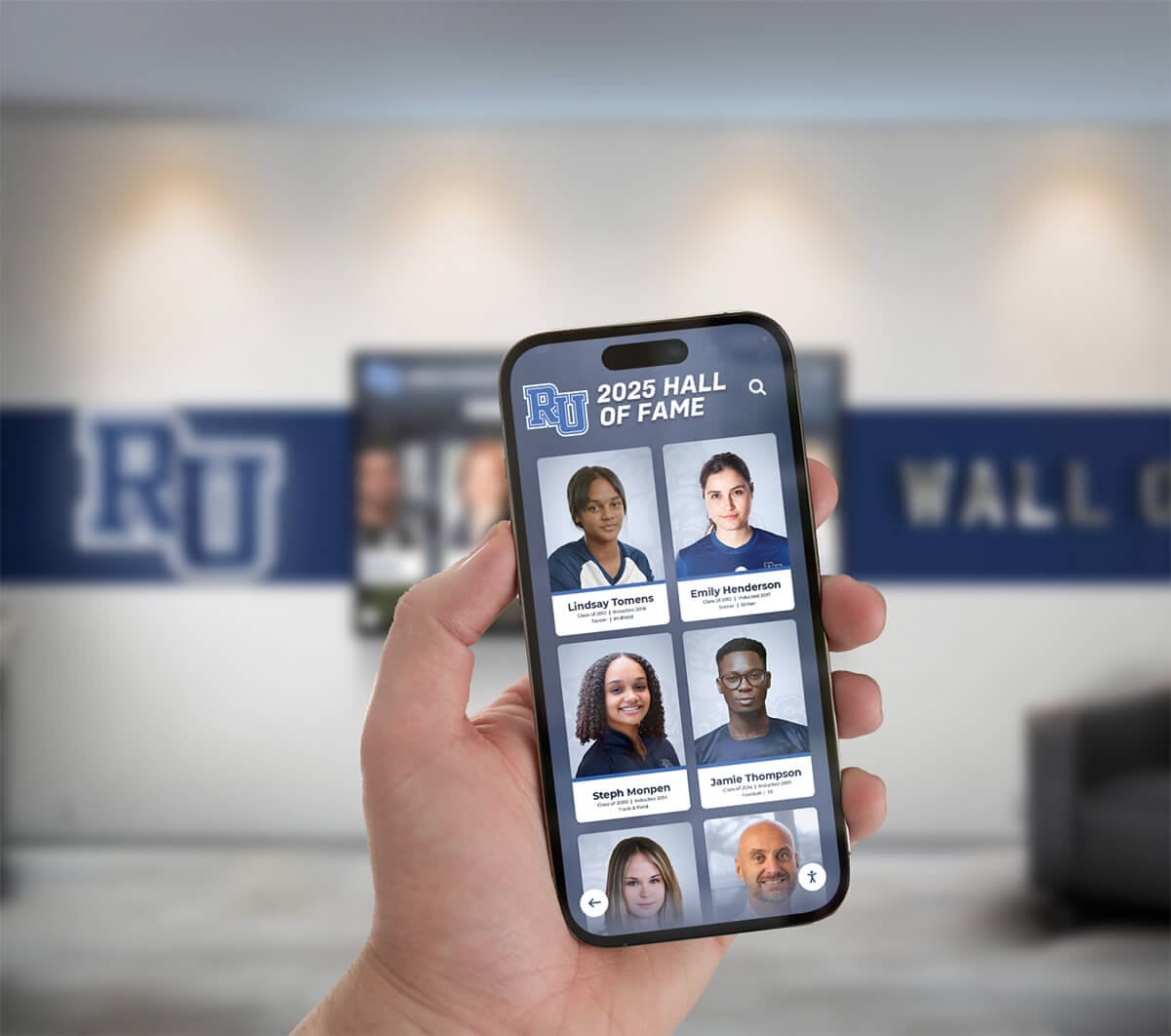
Types of Collegiate Donor Walls: Traditional and Modern Approaches
Universities choose from several recognition formats, each offering distinct advantages and considerations depending on budget, space, donor volume, campus architecture, and institutional culture.
Traditional Physical Recognition Approaches
Physical recognition has served as higher education fundraising cornerstones for generations, providing tangible permanence alumni donors find deeply meaningful.
Individual Plaque Systems: Brass, bronze, or acrylic plaques mounted on dedicated walls remain traditional collegiate donor recognition formats. Individual plaques typically include donor names, class years, degrees earned, giving levels or society memberships, and sometimes brief personal messages or designations. This approach offers significant flexibility—plaques can be added individually over time without complete wall redesigns, relocated if necessary for space management, and customized with varying information depths reflecting different recognition tiers.
However, plaque walls face substantial limitations in higher education contexts including finite capacity eventually requiring wall expansion or difficult decisions about which donors to include when space fills, ongoing costs ($175-450 per plaque plus installation) that compound as donor bases grow, maintenance challenges as plaques age, tarnish, or become damaged, and limited information capacity restricting recognition to basic details without room for stories explaining motivations or demonstrating impact.
Engraved Panel Systems: Consolidated donor walls featuring large panels engraved with multiple donor names provide clean, uniform aesthetics accommodating many alumni in relatively compact spaces. Panel systems work particularly well for annual giving society recognition where hundreds of donors at similar levels receive acknowledgment within cohesive visual presentations. Universities typically arrange donors by giving tier in columns or grids within each recognition level, sometimes organized further by class year or alphabetically.
Panel systems create polished, professional appearances appropriate for prestigious campus locations, but they lack individual plaques’ flexibility. Adding new donors requires creating entirely new panels or leaving blank spaces that appear incomplete during fundraising campaigns. This inflexibility often results in annual update cycles where panels are replaced once yearly, creating recognition delays that can frustrate alumni donors expecting prompt acknowledgment of their generosity.
Donor Trees and Artistic Installations: Creative recognition designs incorporating donor names into artistic elements—metal trees with engraved leaves representing donors, brick pathways, decorative mosaics, sculptural installations—provide visually striking alternatives particularly appropriate for outdoor campus spaces or architecturally significant buildings. These artistic approaches can become campus landmarks creating strong visual identities for giving programs while accommodating large donor volumes through creative designs integrating hundreds or thousands of names into cohesive artistic statements.
Primary challenges involve higher upfront costs for custom fabrication appropriate to campus architecture and institutional brand standards, limited update flexibility once artistic installations are permanently installed, potential difficulties maintaining consistent aesthetics when adding donors over extended periods as artistic visions evolve or original fabricators become unavailable, and weather exposure concerns for outdoor installations in climates with harsh conditions.
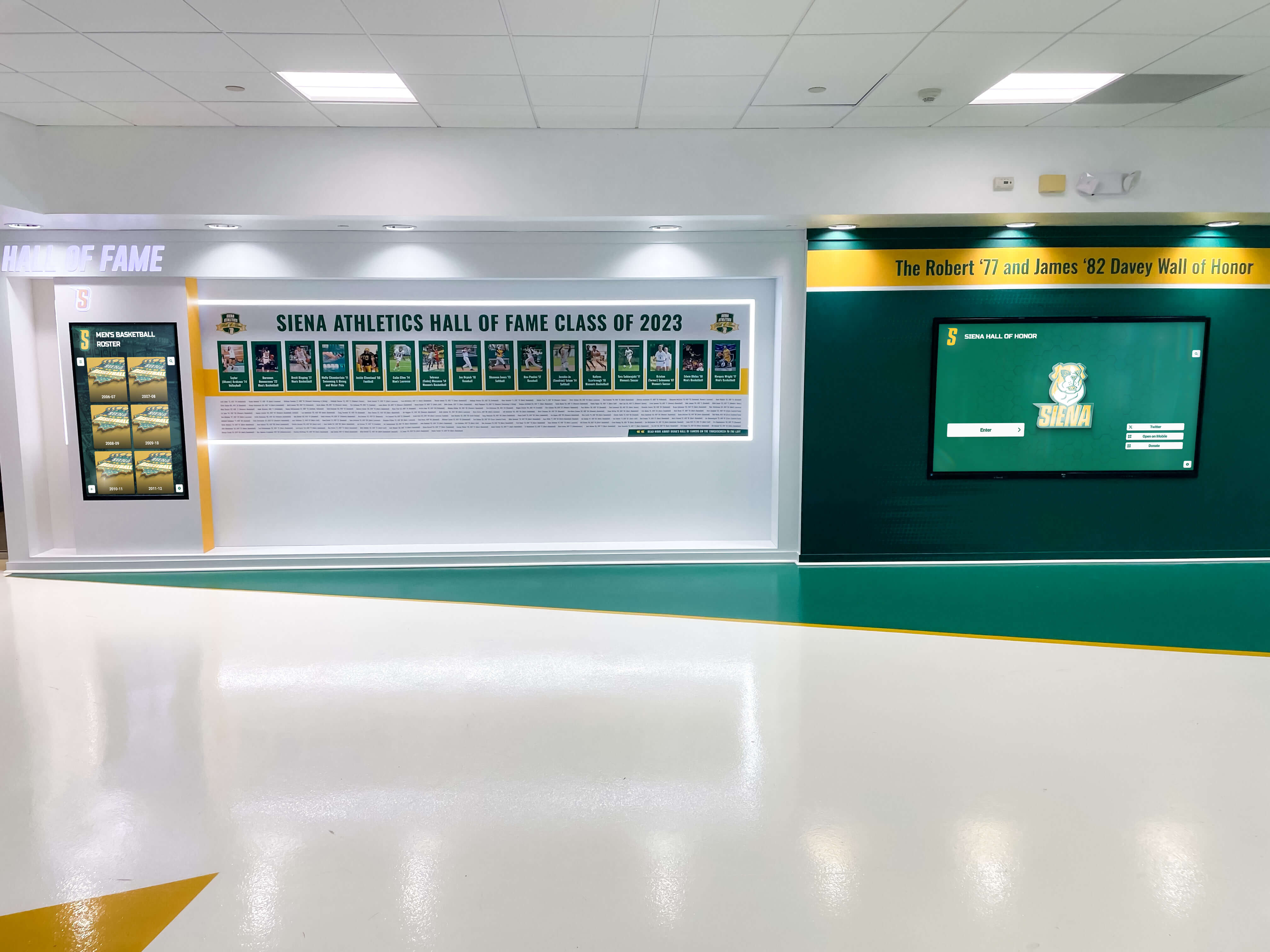
Digital Interactive Recognition Displays
Modern digital solutions represent contemporary alternatives to traditional physical walls, leveraging technology to create dynamic, engaging donor experiences while solving many limitations physical recognition faces in higher education environments managing thousands of alumni donors.
Interactive Touchscreen Systems: Commercial-grade touchscreen displays ranging from 43 to 86 inches enable campus visitors to explore alumni donor profiles through intuitive touch interaction. Unlike static plaques accommodating perhaps 50-100 words per donor, digital profiles support extensive content including complete biographical narratives describing career paths, professional achievements, and contributions to their fields; comprehensive giving histories showing progression from early-career modest gifts through major commitments over decades; multiple photos connecting donors to campus experiences, student activities, athletic participation, and current institutional relationships; video testimonials explaining motivations for support and reflecting on how their education shaped their lives and careers; and detailed impact stories demonstrating concrete outcomes their gifts enabled—scholarships awarded to specific students, research projects funded, facilities constructed, programs supported.
Digital systems provide essentially unlimited capacity—institutions can recognize hundreds or thousands of alumni donors without physical space constraints. Whether acknowledging 75 distinguished major donors or 7,500 annual fund supporters, display footprints remain constant at a single kiosk location. Content updates occur instantly through simple web interfaces without manufacturing plaques or coordinating installation logistics. Advancement professionals add new donors, update information, or feature different contributors through cloud-based platforms requiring no technical expertise.
Perhaps most significantly for data-driven advancement operations, digital recognition provides detailed analytics tracking visitor engagement—average interaction duration revealing content engagement depth, most-viewed profiles indicating what resonates most powerfully with campus audiences, search patterns showing how visitors explore content and what they seek, peak usage times informing event scheduling and promotional timing, and return visitor rates demonstrating whether recognition creates sustained interest. These insights enable continuous improvement based on real user behavior rather than assumptions about what engages alumni donor audiences.
Web-Based Digital Recognition Portals: Online donor recognition extends acknowledgment beyond those who can visit physical campus locations, creating accessible recognition for geographically distributed alumni communities. Web portals provide searchable databases where alumni, students, parents, and community members can explore donor profiles from anywhere, share recognition with their networks through social media platforms, access content on any device at any time, and feel connected to campus philanthropic communities regardless of geographic distance.
Online recognition proves particularly valuable for universities with internationally distributed alumni populations, institutions serving regional or national constituencies rather than local communities, and colleges with significant online or distance learning programs where many graduates never regularly visited traditional campuses. Virtual hall of fame platforms ensure all supporters receive recognition regardless of their ability to visit campus physically, democratizing recognition access across entire alumni communities.
Hybrid Recognition Strategies: Many universities implement hybrid approaches combining physical and digital recognition to leverage advantages of each format while respecting different generational preferences and serving varied recognition purposes. Prominent touchscreen displays in high-traffic campus locations create primary recognition experiences for visitors, students, and alumni attending campus events while serving as visible reminders of giving opportunities and philanthropic traditions. Traditional physical plaques in special locations—boardrooms, named facilities, donor lounges, presidential suites—honor top-tier major donors with tangible permanence highly valued by transformational gift prospects considering building naming or endowment opportunities. Web-accessible recognition portals extend acknowledgment to alumni supporters worldwide who cannot regularly visit campus but want to feel connected to institutional philanthropic communities.
This multi-channel approach ensures recognition reaches diverse audiences through their preferred platforms, maximizing engagement and fundraising impact while building comprehensive systems serving varied needs within complex institutional advancement programs managing annual giving, major gifts, planned giving, corporate relations, and foundation partnerships simultaneously.
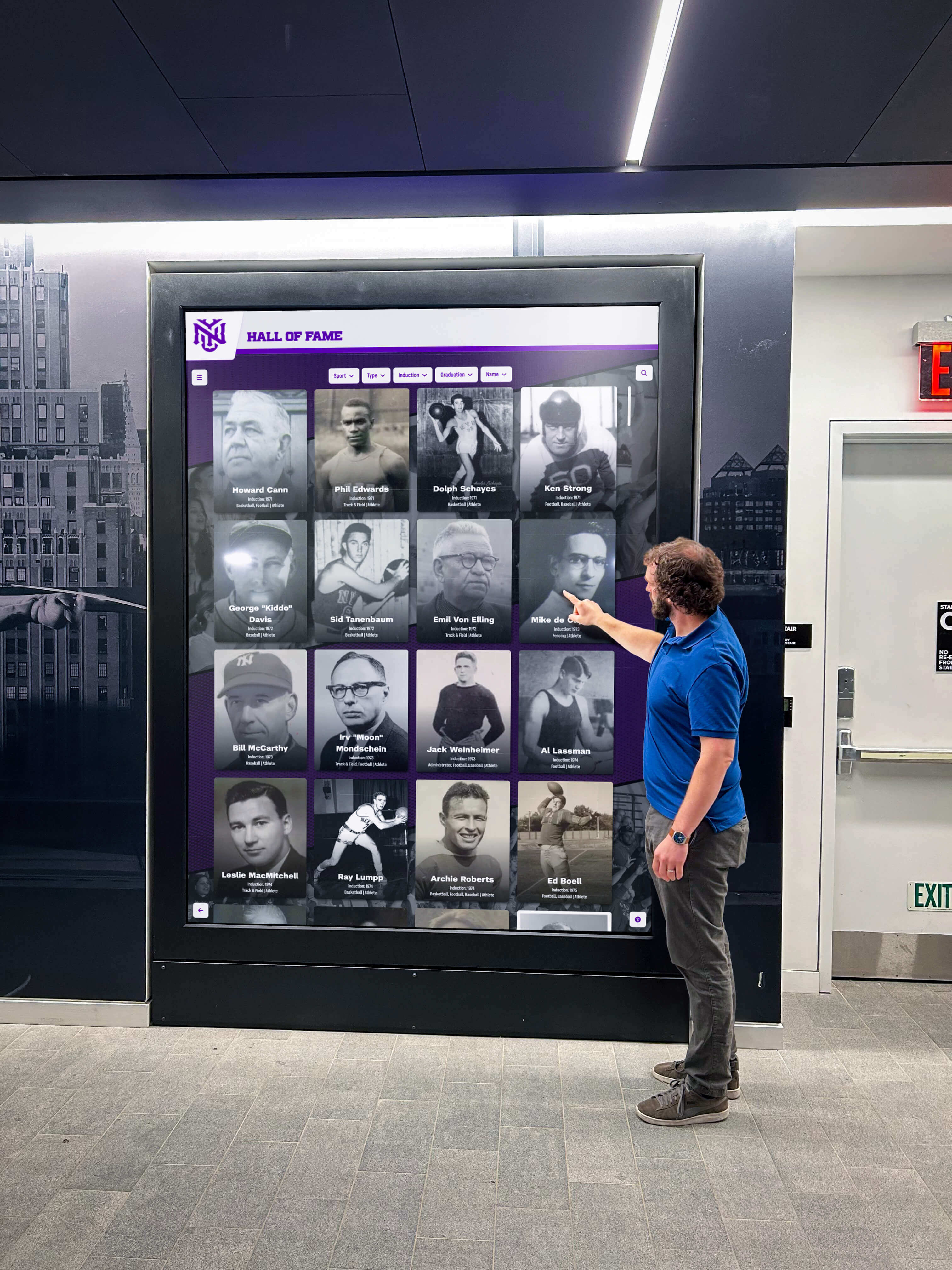
Planning Your Collegiate Donor Wall Program
Successful collegiate donor recognition begins with comprehensive planning aligning donor walls with institutional fundraising priorities, campus master planning, and organizational capacity for ongoing management.
Defining Recognition Criteria and Giving Level Structures
Clear, consistent criteria ensure recognition programs maintain credibility and fairness while serving strategic fundraising objectives without appearing arbitrary or creating perceptions of inequity within alumni communities.
Establishing Recognition Thresholds: Universities must determine what contribution levels qualify for donor wall inclusion. Strategic options include recognizing all alumni donors regardless of amount to build broad participation culture and community, establishing minimum thresholds ($500, $1,000, $5,000+) balancing comprehensive recognition against practical limitations, creating cumulative lifetime giving thresholds recognizing sustained multi-year support over single gifts, reserving premier wall of honor recognition for certain giving levels while acknowledging smaller donors through other channels like annual reports or online listings, or combining approaches with different recognition venues serving different donor segments.
Many universities create comprehensive tiered recognition structures allowing inclusive acknowledgment while maintaining meaningful distinction for truly exceptional gifts. Common structures include:
- Benefactor Society ($100,000+): Premier lifetime giving recognition with largest profiles, premium positioning, enhanced multimedia content including video testimonials and extensive biographical narratives
- Leadership Circle ($50,000-$99,999): Featured profiles with extended biographical content, career highlights, detailed giving histories, and impact stories
- President’s Society ($25,000-$49,999): Substantial profiles with photos, career summaries, philanthropic motivations, and institutional connections
- Patron Circle ($10,000-$24,999): Standard profiles with photos, biographical information, and acknowledgment of designated giving interests
- Loyalty Society ($5,000-$9,999): Recognition listings with names, class years, degrees, and brief acknowledgments
- Annual Fund Society ($1,000-$4,999): Listed acknowledgment within collective donor galleries organized by class year
According to research from higher education advancement organizations, universities with clearly defined giving society structures experience 30-45% higher upgrade rates as donors work systematically toward next recognition tiers compared to institutions with unclear or inconsistent recognition criteria.
Cumulative vs. Single-Gift Recognition: Universities must decide whether recognition reflects individual gifts, cumulative lifetime giving, or both approaches serving different strategic purposes. Cumulative recognition encourages sustained support and upgrade progression as alumni donors work toward higher recognition tiers over time through consistent annual giving, periodic campaign participation, and special project support. This approach rewards loyalty and long-term commitment, often proving more effective for building sustainable annual giving cultures.
Single-gift recognition emphasizes individual transformational contributions and proves particularly effective during capital campaigns when institutions seek large one-time commitments establishing fundraising momentum and inspiring other major donors. Campaign-specific recognition walls celebrating gifts to particular initiatives create urgency and social proof during active solicitation periods.
Many comprehensive universities combine both approaches—capital campaign walls recognize specific campaign gifts inspiring current giving, while institutional walls acknowledge cumulative lifetime support honoring long-term commitment. This dual recognition strategy serves immediate campaign needs while building sustainable annual giving cultures that support operations beyond campaigns.
Academic and Affiliation-Based Recognition Options: Collegiate environments enable recognition organized around academic programs, schools, colleges, athletic programs, and campus affiliations. Alumni recognition walls incorporating these dimensions create stronger personal connections as donors see themselves acknowledged within contexts most meaningful to their individual experiences—engineering school alumni recognized within engineering facilities, athletic donors honored in stadiums and field houses, arts supporters celebrated in performing arts centers.
This affiliation-based approach serves fundraising purposes by inspiring designated giving to specific programs while honoring donors in contexts most meaningful to their institutional relationships. Universities often create both comprehensive institutional recognition celebrating overall support and program-specific recognition within individual schools or departments, building comprehensive systems serving varied advancement priorities.
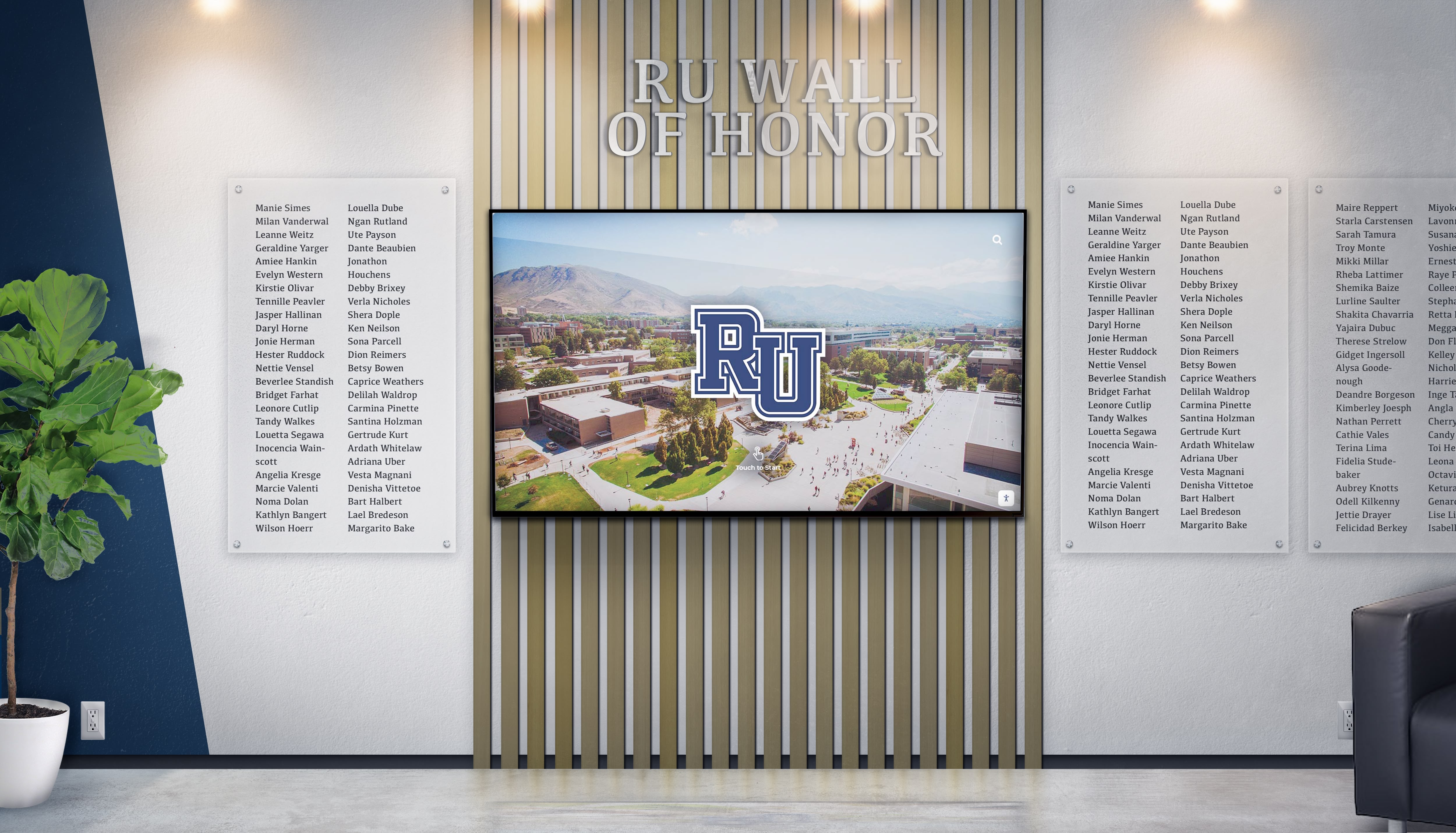
Budget Planning and Funding Strategies
Comprehensive budgeting ensures recognition programs remain financially sustainable while generating positive returns through enhanced fundraising results justifying initial and ongoing investments.
Physical Wall Budget Components:
For traditional recognition approaches:
- Materials and Fabrication: $12,000-$150,000+ depending on size, materials quality, custom design, and architectural integration requirements
- Architectural/Design Services: $6,000-$30,000 for custom design development, specifications, and campus master plan integration
- Installation Labor: $4,000-$18,000 for professional mounting, finishing, lighting systems, and architectural detailing
- Ongoing Plaque Additions: $175-450 per alumni donor for manufacturing, engraving, and professional installation
- Maintenance and Restoration: $1,500-$5,000 annually for cleaning, repairs, plaque replacement, lighting maintenance, and updates
- Future Expansion: Budget reserves for wall extensions when initial capacity fills, often 30-50% of original installation costs
Digital Display Budget Components:
For modern recognition platforms:
- Hardware (Touchscreen Displays): $12,000-$35,000 for commercial-grade equipment rated for continuous institutional operation
- Software Platform and Setup: $8,000-$22,000 for purpose-built higher education recognition systems with alumni-specific features
- Content Development: $10,000-$30,000 depending on initial donor volume, biographical research requirements, photography, video production, and multimedia complexity
- Installation and Infrastructure: $4,000-$9,000 for professional mounting, cabling, network connectivity, security enclosures, and integration with campus systems
- Annual Operating Costs: $5,000-$12,000 for platform subscriptions, cloud hosting, technical support, maintenance contracts, and software updates
- Content Management: Ongoing staff time for donor additions, profile updates, system administration, and strategic content curation
While initial digital investments appear substantial, these systems typically generate positive ROI within 24-36 months through improved donor retention, enhanced giving patterns, operational efficiencies in recognition management, and elimination of ongoing costs for physical updates that compound dramatically over time as alumni donor bases grow from hundreds to thousands of contributors.
Funding the Recognition Program: Universities commonly fund donor recognition programs through several approaches including capital campaign budgets where recognition represents essential campaign infrastructure, institutional advancement operating budgets for ongoing recognition as core development function, designated gifts from leadership donors who underwrite recognition programs as their philanthropic contribution, corporate sponsorships where business partners support recognition in exchange for appropriate acknowledgment, or combinations of these approaches creating sustainable funding models.
Some institutions establish endowments specifically supporting perpetual recognition program operations, ensuring long-term sustainability beyond current campaign cycles or budget constraints. This endowment approach proves particularly effective for institutions committed to comprehensive, high-quality recognition as ongoing advancement priority rather than episodic campaign-driven initiatives.
Location Selection and Campus Integration
Even excellent recognition engages poorly if positioned in low-traffic areas, poorly integrated with campus architecture, or inadequately promoted to target alumni audiences and campus visitors.
Strategic Campus Location Criteria:
Effective placement maximizes visibility and engagement through:
- Alumni Centers or Advancement Office Buildings: Primary destinations where alumni visit naturally for events, meetings, volunteer activities, and engagement programs
- Main Campus Building Entrances: High-visibility locations in student unions, libraries, administration buildings, or iconic campus structures where students, faculty, visitors, and prospective families naturally congregate
- Athletic Facilities: Stadiums, arenas, field houses hosting games, competitions, and alumni gatherings ensuring consistent exposure during peak engagement opportunities
- Academic Building Commons: Locations where current students regularly study, attend classes, and gather, maximizing student exposure to philanthropic models and accomplished alumni
- Named Facilities Funded by Major Donors: Strategic placement in buildings or spaces donors helped create, connecting recognition directly to tangible impact while inspiring prospects considering similar naming opportunities
Consider both quantity and quality of traffic—locations with modest total foot traffic but high alumni donor concentration often outperform higher-traffic locations where few visitors are donors or prospects. Alumni center lobbies, despite lower absolute traffic than student centers, provide superior prospect exposure because visitors are typically already engaged in advancement relationships, attending donor events, or participating in cultivation activities.
Architectural Integration and Campus Character: Collegiate donor walls should complement campus architecture and institutional character rather than appearing as afterthoughts or incompatible additions. Universities with historic campuses require recognition solutions respecting architectural heritage and historic preservation standards. Modern campuses enable contemporary recognition approaches reflecting institutional innovation and forward-thinking values. Liberal arts colleges may prefer intimate, personal recognition approaches while major research universities might implement comprehensive systems reflecting institutional scale and complexity.
Working with campus architects, facilities planning departments, and historic preservation offices ensures recognition programs integrate appropriately with campus master plans, respect architectural standards, and position universities for long-term success rather than creating installations requiring expensive modifications or replacements when campus development plans evolve.
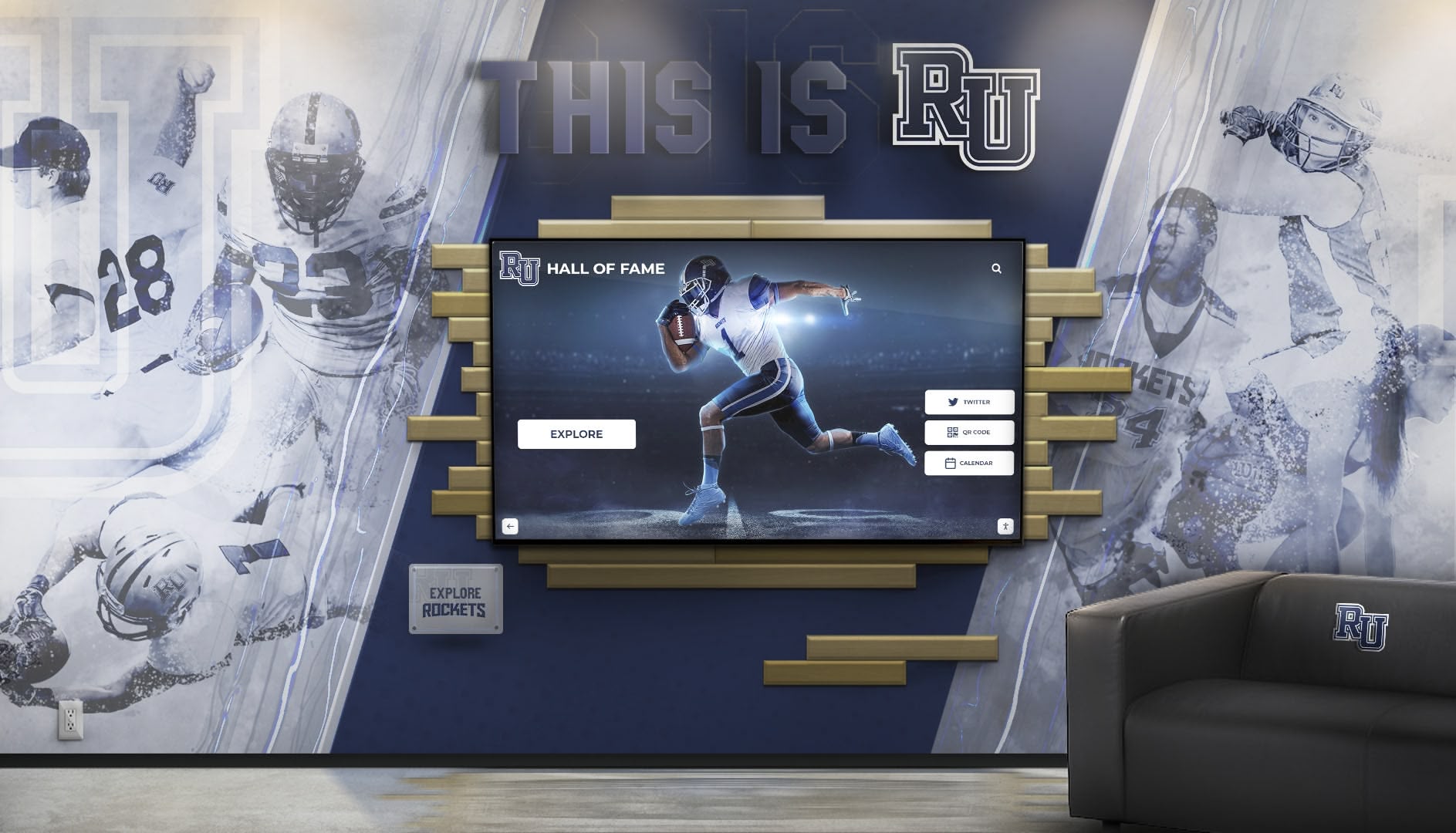
Content Strategy and Donor Storytelling
Compelling content forms the foundation of effective collegiate donor recognition—without interesting, well-organized information reflecting donors’ diverse motivations and institutional connections, even sophisticated displays fail to engage visitors meaningfully or inspire giving.
Comprehensive Alumni Donor Profile Components
Effective recognition includes multiple content elements creating complete pictures of donors, their educational experiences, their lives and accomplishments, and their motivations for supporting their alma mater.
Essential Profile Information:
- Names and Recognition Dates: Essential identification with proper titles, preferred names, maiden names when applicable, and class year information
- Degree Information: All degrees earned from the institution including undergraduate, graduate, and professional degrees with majors, programs, and academic honors
- Biographical Narratives: 400-1,200 word profiles providing career paths, professional accomplishments, industry contributions, community involvement, family information, and life context demonstrating impact of their education
- Campus Experience Reflections: First-person accounts describing formative professors, meaningful courses, influential campus activities, athletic participation, student organizations, friendships formed, or pivotal moments during college years
- Philanthropic Motivations: Explanations of why donors support their alma mater, what their education meant to them, which programs or experiences they want to sustain for future students, and values driving their generosity
- Contribution Information: Giving levels, campaign participation, designation specifics, endowment funds established, or facilities supported (respecting donor privacy preferences)
- Professional Photography: High-quality portraits, current photos, historical yearbook images, or candid photos showing donors in campus settings or with students they support
- Impact Stories: Narratives connecting gifts to concrete outcomes—scholarship recipients profiled, research breakthroughs enabled, facilities constructed, programs supported, or student opportunities created
- Video Testimonials: First-person recorded messages explaining giving motivations, reflecting on educational impact, and encouraging fellow alumni support (for digital displays)
- Multi-Generational Connections: Recognition of family giving legacies when children, siblings, spouses, parents, or extended family also attended and support the institution
This comprehensive approach transforms basic acknowledgment into meaningful storytelling that honors donors’ complete relationships with institutions while creating compelling content inspiring prospective donors who observe how their alma mater celebrates supporters.
Information Organization and Navigation
Structure content enabling intuitive exploration through multiple organizational approaches serving different user needs and discovery patterns.
Primary Organization Structures:
- Giving Level Tiers: Primary organization by cumulative or campaign contribution levels with clearly differentiated visual recognition treatment reflecting gift significance
- Class Year Groupings: Traditional arrangements facilitating reunion-year fundraising, class competition dynamics, and peer discovery as alumni locate classmates
- Alphabetical Listings: Simple organization enabling quick name searches when visitors seek specific individuals without knowing their class year or giving level
- Academic Affiliation: Organization by school, college, department, or major connecting donors with programs they support or studied within
- Athletic Team Organization: Recognition grouped by sport for athletic donors, creating team-based communities and competitive dynamics
- Designation Categories: Grouping by gift purpose—endowed scholarships, facility naming, program funds, unrestricted annual giving, or specific campaign priorities
- Recognition Societies: Featured collections of donors meeting specific criteria or membership thresholds establishing aspirational communities
Interactive alumni directories supporting multiple simultaneous organizational approaches through powerful search and filtering enable visitors to explore content through various pathways based on their interests, relationships, class years, academic backgrounds, or giving priorities without constraining content into single organizational schemes.
Gathering Donor Content and Stories
Collecting rich, engaging content requires systematic approaches and stakeholder collaboration across advancement divisions, alumni relations teams, academic departments, and institutional communications.
Content Collection Methodologies:
Universities gather comprehensive donor information through direct outreach with personalized requests to recognized donors asking for updated biographical information, professional photos, campus memory reflections, and giving motivation statements; advancement database mining extracting information from CRM systems, contact records, giving histories, event attendance, and volunteer participation data; archival research reviewing institutional publications, yearbooks, alumni magazines, and archives for historical context, vintage photos, and accomplishments; academic department collaboration accessing information about distinguished alumni within specific programs, schools, or departments; athletic department coordination for student-athlete donors and team affiliation information; and family collaboration working with donor families, particularly for deceased legacy supporters, to access photos, biographical information, and personal stories.
Content development often takes 6-12 months for initial implementation with hundreds of donors, representing the most time-intensive aspect of project launches. However, this upfront investment creates valuable institutional archives benefiting recognition programs, advancement communications, campaign materials, alumni magazines, and recruitment materials for years to come. Many universities discover compelling alumni stories during recognition research that prove valuable far beyond donor walls themselves—stories suitable for feature articles, speaker recruitment, student mentoring programs, or major gift cultivation.
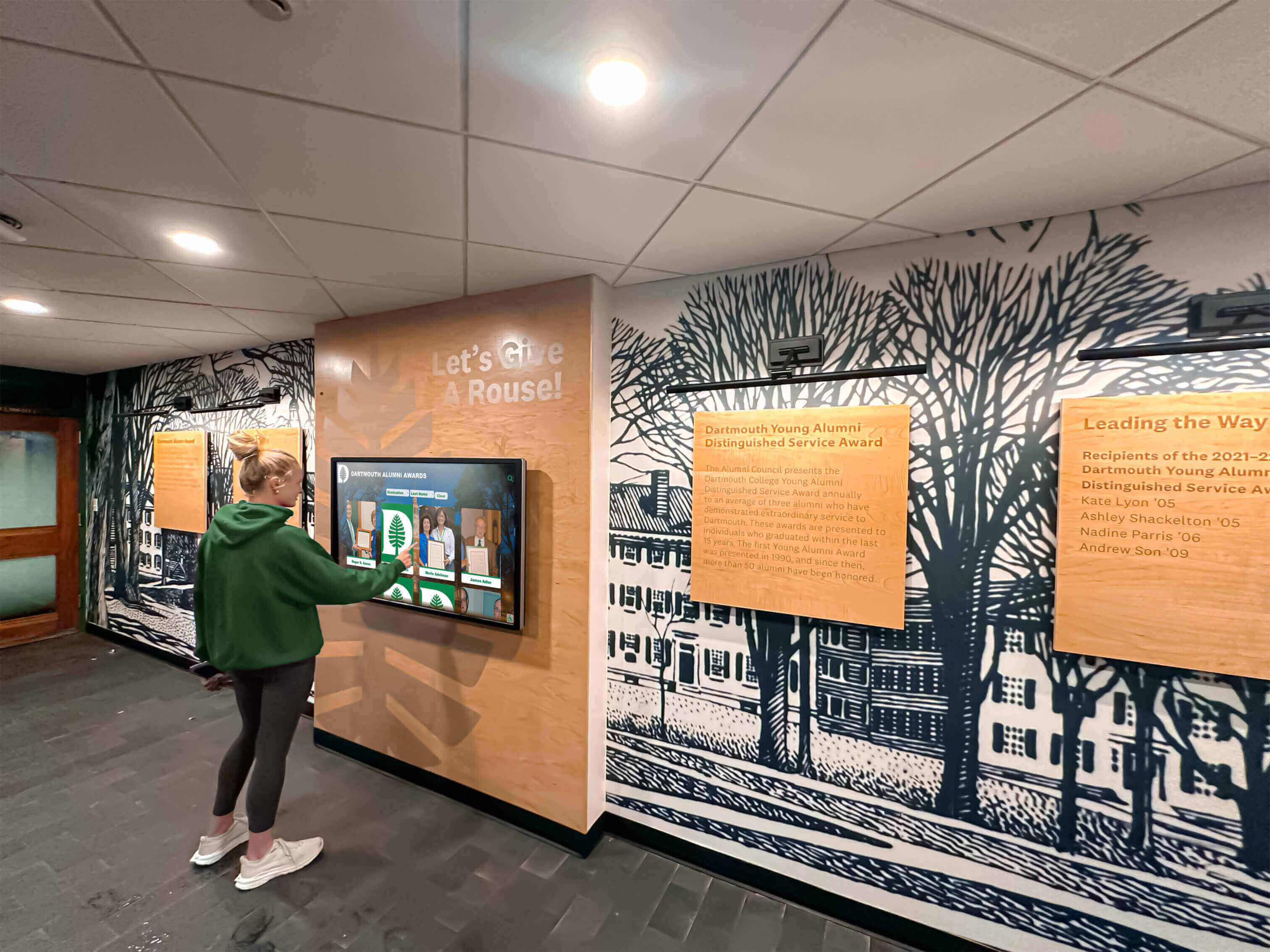
Design Principles for Effective Collegiate Donor Walls
Whether implementing traditional physical walls or modern digital displays, effective design balances aesthetic appeal with functional clarity, communicates institutional values and traditions, and creates engaging experiences that honor donors while inspiring giving.
Visual Hierarchy and Recognition Differentiation
Clear visual distinctions between giving levels reinforce recognition programs’ tiered structures while respecting donors at all levels appropriately without creating obvious two-class systems.
Proportional Recognition Treatment: Higher giving tiers receive proportionally enhanced recognition through larger plaques or expanded digital profiles with additional content sections and multimedia elements, premium positioning in high-visibility locations or prominent screen positions and navigation, enhanced photography and videography production quality, exclusive features like video testimonials, impact visualizations, or special biographical treatments, and distinct visual treatment through color coding, decorative borders, special materials, or design elements signaling recognition tier.
This differentiation should be substantial enough to clearly distinguish levels and create upgrade motivation while remaining tasteful and proportionate—avoid making lower-tier recognition appear insignificant, apologetic, or suggesting their contributions lack importance. All alumni donors deserve respectful acknowledgment regardless of capacity. The goal is meaningful distinction that motivates aspiration toward higher levels without demeaning supporters giving what they can afford at their current life stages or career points.
Institutional Branding and Aesthetic Excellence
Collegiate donor walls function as prominent institutional statements that should reflect organizational identity, academic traditions, and values through thoughtful design demonstrating professional standards befitting higher education institutions.
Brand Alignment and University Identity: Incorporate institutional colors, official logos, typography standards, and visual styles ensuring recognition walls feel fully integrated with broader organizational identity rather than appearing as afterthoughts or separate initiatives disconnected from campus environment. This consistency strengthens brand recognition, demonstrates professional attention to detail building confidence among alumni donors and prospects, and positions recognition as core institutional priority rather than peripheral advancement activity.
Universities with strong athletic traditions might integrate school mascots, team colors, or sports imagery where appropriate. Liberal arts colleges may emphasize academic excellence, intellectual achievement, and diverse fields of study. Research universities could highlight innovation, discovery, and scholarly impact. Community colleges might focus on accessibility, opportunity, and transformative education for diverse student populations. Design choices should authentically reflect institutional character and values rather than implementing generic recognition approaches lacking distinctive identity.
Material Selection and Quality Standards: Materials and finishes communicate institutional values and priorities to alumni communities, campus visitors, and prospective students. Premium materials—solid woods, quality metals, commercial-grade displays, professional fabrication—signal that universities value excellence and invest appropriately in honoring supporters. Budget materials, amateur execution, or obvious cost-cutting measures undermine fundraising by suggesting institutions don’t truly value contributions they’re supposedly celebrating.
This doesn’t require extravagant expense, but does demand appropriate quality matching institutional standards evident throughout campus facilities, academic buildings, and communications. Alumni donors naturally compare recognition displays to other institutional investments—new academic buildings, athletic facilities, student centers—forming judgments about whether advancement offices appropriately value their philanthropy based on recognition quality relative to other campus priorities.
Creating Engaging Discovery Experiences
Recognition should invite exploration and extended engagement rather than functioning as passive displays visitors glance at while passing through lobbies or hallways without stopping.
Interactive Elements and User Experience:
Digital recognition systems should incorporate features dramatically increasing engagement including powerful search with auto-complete helping visitors quickly locate specific alumni donors, classmates, teammates, professors, or familiar names; multi-parameter filtering by giving level, graduation year, academic program, designation type, or custom categories like student organization, athletic team, or geographic region; related content connections automatically suggesting donors with similar interests, giving patterns, career fields, or shared campus experiences; social sharing integration enabling one-click sharing of recognition to social media platforms extending visibility beyond physical displays; multimedia presentations through photo galleries showing donors at campus events, video testimonials explaining motivations, and impact visualizations demonstrating scholarship recipients or facilities funded; and discovery features like “featured donor of the month” spotlights, themed collections encouraging comprehensive exploration, or gamification elements rewarding profile exploration.
According to research from digital engagement specialists, users spend an average of 6-8 minutes exploring well-designed interactive donor recognition compared to 30-60 seconds scanning traditional static walls—representing 8-12x engagement time that creates proportionally stronger emotional impact and giving motivation.
Storytelling Over Transactional Lists: Transform basic recognition into compelling narratives creating emotional bonds between campus visitors and donors. Instead of simply listing names and gift amounts, tell complete stories about what inspired alumni donors to give and maintain support over years or decades, personal connections to institutions and specific experiences during college years that shaped their lives, concrete impact their gifts enabled for students who benefited directly from scholarships or programs funded, values and principles motivating their philanthropy and what they hope to accomplish, and future vision their contributions support through endowments providing perpetual support.
These stories transform recognition from transactional acknowledgment into inspirational content motivating prospective donors while deeply honoring existing supporters whose generosity deserves meaningful celebration beyond name listings. Highlighting donor recognition through rich storytelling creates recognition experiences alumni value receiving, want to share with networks, and aspire to achieve through increased giving.
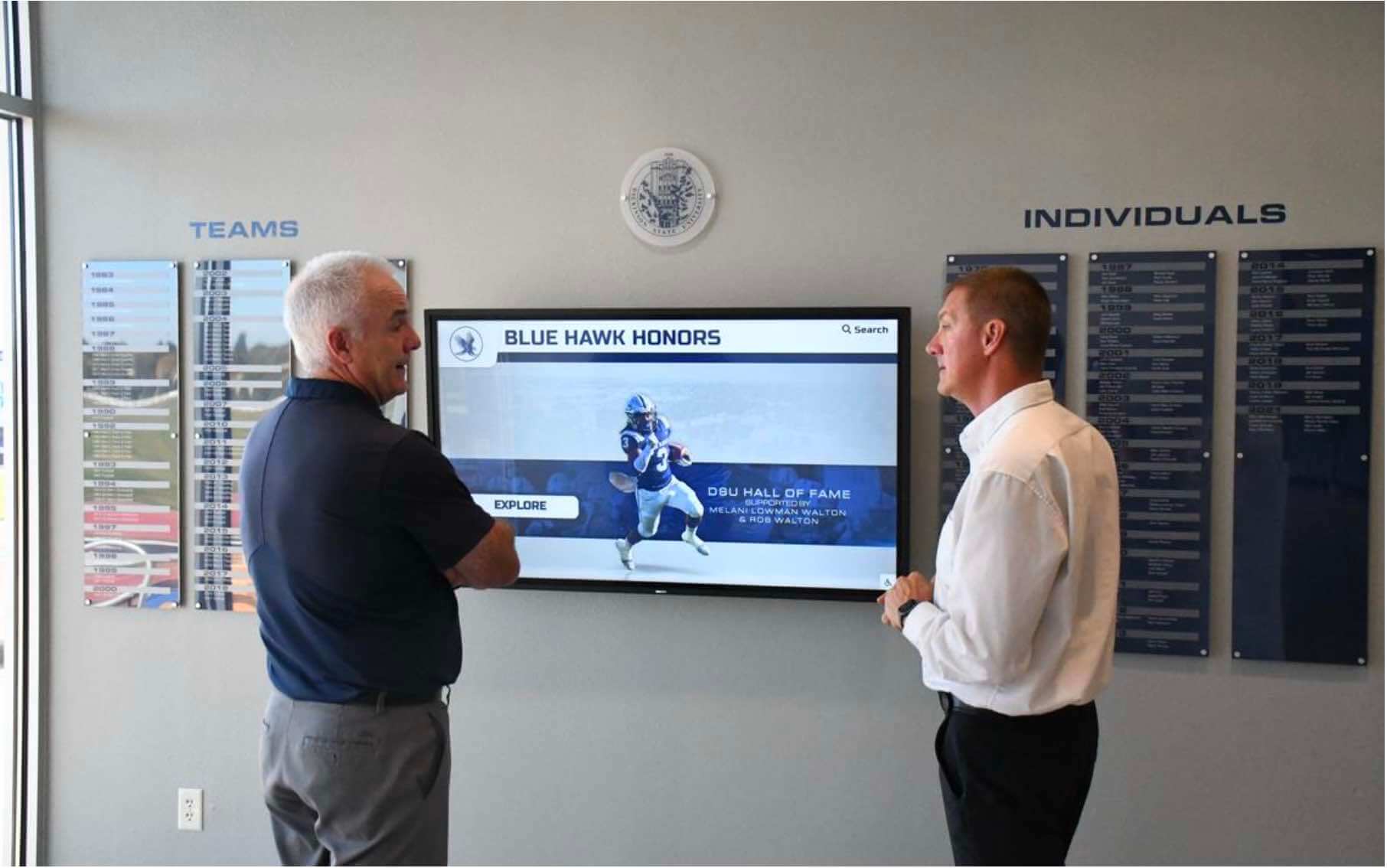
Implementation: Bringing Your Collegiate Donor Wall to Life
Moving from planning to reality requires systematic implementation addressing content development, technology deployment, campus integration, and community launch creating excitement and establishing ongoing engagement patterns.
Professional Installation and Technical Deployment
Professional implementation ensures recognition displays function reliably while creating polished impressions befitting institutional standards and honoring donors appropriately.
Physical Wall Installation Process:
For traditional recognition approaches:
- Campus Coordination: Work with facilities departments, campus planning, and potentially historic preservation offices for installation approvals, utility location, and building access
- Site Preparation: Wall surface preparation, structural reinforcement if needed for weight loads, background finishing, and architectural detailing
- Layout Planning: Precise measurements, level lines, and positioning plans ensuring accurate plaque or panel placement with room for future expansion
- Mounting Hardware Installation: Secure fasteners appropriate to wall construction (masonry, drywall, concrete), load-bearing capacity verification, and recognition element weight
- Element Installation: Professional mounting of plaques, panels, or artistic components with consistent spacing, perfect alignment, and quality finishes
- Lighting Systems: Dedicated lighting highlighting recognition without creating glare, ensuring visibility throughout day and evening, and complementing architectural lighting
- Final Quality Inspection: Comprehensive review verifying level placement, secure mounting, professional appearance, lighting effectiveness, and donor satisfaction
Digital Display Deployment:
For modern recognition platforms:
- Campus Infrastructure Assessment: Electrical capacity evaluation, network connectivity planning (hardwired Ethernet strongly preferred over WiFi for reliability), and structural wall reinforcement assessment for heavy commercial displays
- Hardware Installation: Professional mounting with appropriate security fasteners, clean cable management within walls or approved raceways, protective enclosures if needed for high-traffic areas or outdoor applications
- Network Configuration: Connecting displays to campus networks with appropriate security protocols, bandwidth allocation, firewall rules, and IT department coordination
- Software Platform Setup: Cloud platform configuration, institutional branding implementation, user account creation, permission structure establishment, and content database initialization
- Display Calibration: Touch response calibration ensuring accurate interaction, color and brightness optimization for ambient lighting conditions, audio system testing if applicable, and power management configuration
- Integration Testing: Verification of all interactive features, search functionality accuracy, multimedia playback quality, network reliability, and performance optimization
- Security Hardening: Operating system lockdown preventing unauthorized access or tampering, physical security measures, remote management configuration, and backup systems
Solutions like Rocket Alumni Solutions provide turnkey implementation services handling technical deployment, allowing advancement teams to focus on donor relationships and content rather than managing complex technology installations.
Launch Strategy and Campus Community Introduction
Strategic launch communicates recognition value and builds excitement around new programs while maximizing initial engagement establishing patterns for ongoing visibility.
Pre-Launch Promotion: Build awareness and anticipation before formal launch through donor notification with personal communications to recognized alumni announcing new recognition and inviting them to dedicated preview events or virtual tours, campus-wide communications through email announcements to broader alumni communities highlighting new recognition programs and giving opportunities, student engagement through campus newspaper articles, student organization presentations, or orientation programs introducing current students to philanthropic traditions, social media campaigns with preview content, donor testimonials, and construction progress updates building anticipation, and website updates creating dedicated landing pages explaining recognition programs, providing background on inaugural inductees, and connecting recognition to giving opportunities.
Launch Event Planning: Create memorable launch experiences celebrating philanthropy and honored donors through strategic timing coinciding with significant gatherings—homecoming, commencement, major athletic events, reunion weekends, or campaign announcements maximizing attendance from target audiences; donor-centered celebrations framing events as honoring donors rather than institutional self-promotion, maintaining appropriate gratitude-centered tone throughout programs; leadership participation featuring presidents, provosts, board chairs, and campaign leaders demonstrating organizational commitment to donor recognition; interactive demonstrations providing hands-on opportunities for attendees to explore recognition, locate their own profiles, discover classmates and friends; media engagement inviting campus and local media for coverage extending reach beyond attendees to broader alumni and community audiences; and feedback collection gathering initial reactions, suggestions for improvements, and testimonial content for future promotional use.
Sustained Visibility Campaigns: Initial launch excitement predictably declines without consistent promotion reminding donors that new content appears regularly warranting return engagement. Implement monthly featured donor spotlights through email newsletters and social media profiles, integrate recognition references into all fundraising events with speakers mentioning recognition or displays positioned at event venues, rotate recognition features on institutional and advancement websites, include recognition updates and featured donor stories in alumni magazines and advancement publications, create short video content spotlighting different donors for digital channels and social media, establish annual recognition induction ceremonies adding new donors with appropriate celebration and publicity, and incorporate recognition tours into prospective student visits demonstrating alumni support and institutional culture.
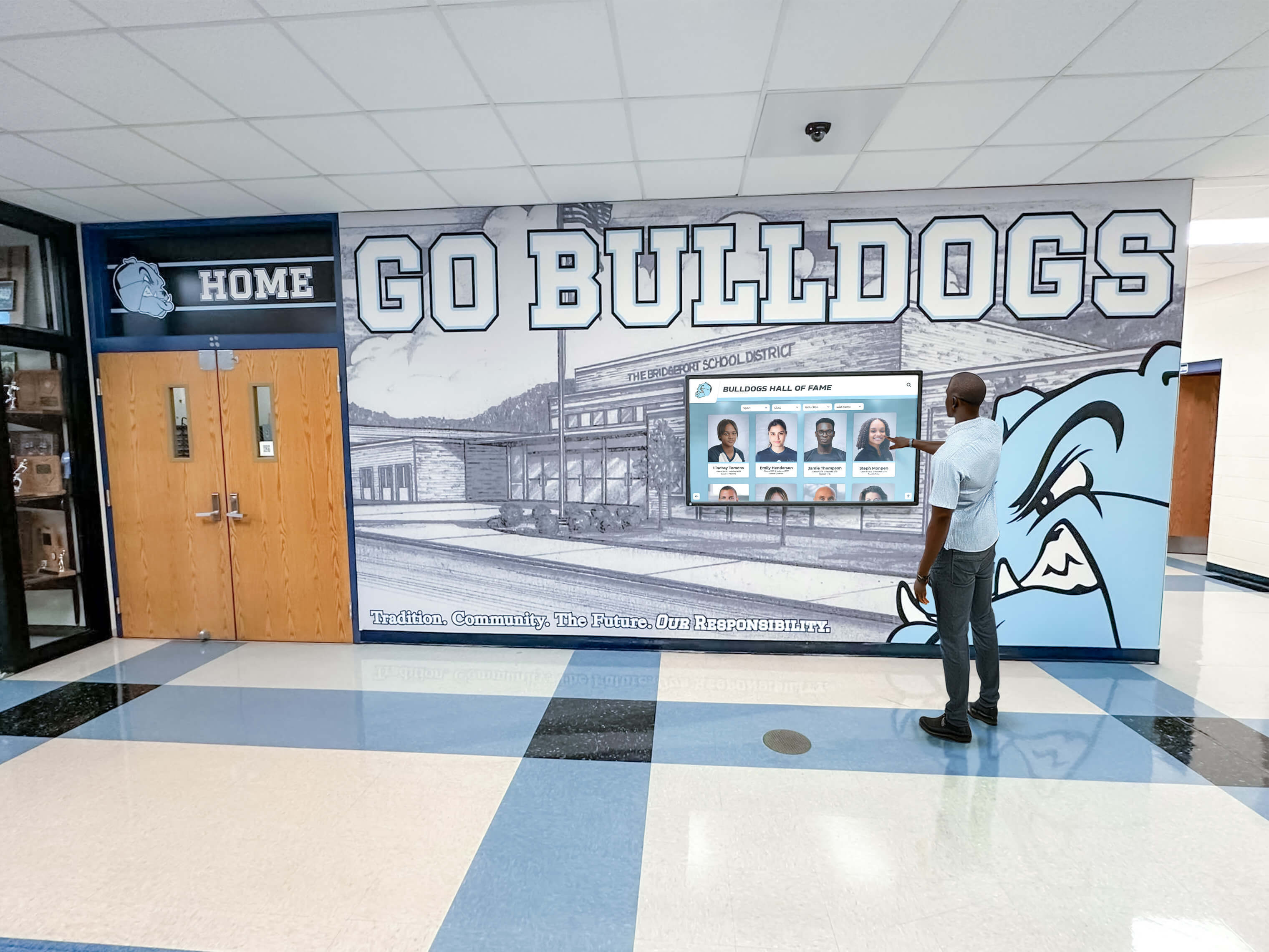
Maximizing Fundraising Impact Through Strategic Recognition
Recognition programs achieve maximum financial returns when integrated seamlessly into comprehensive advancement strategies rather than functioning as isolated initiatives managed separately from core fundraising operations.
Integration with Major Gift Cultivation
Collegiate donor walls serve as powerful tools throughout prospect development pipelines when strategically deployed by development officers cultivating six-figure and seven-figure gift relationships.
Prospect Cultivation Applications:
Use recognition strategically during cultivation including campus tours with routes deliberately including recognition displays demonstrating how institutions celebrate significant contributions and creating concrete visualizations of legacy opportunities; one-on-one meetings in advancement offices, campus locations, or donor lounges with visible recognition displays or using tablets to show digital profiles of peers at comparable wealth levels or shared affiliations; special preview events offering exclusive recognition tours for major gift prospects before public launches, creating insider access and VIP treatment prospects value; case statement materials incorporating high-quality photography of recognition programs highlighting acknowledgment opportunities at various giving levels prospects might consider; and planned giving conversations featuring recognition celebrating legacy donors, modeling behavior for prospects considering estate gifts or creating family philanthropic traditions.
Development officers consistently report that recognition displays provide tangible proof making abstract recognition promises concrete during solicitation conversations. Prospects considering transformational gifts can envision exactly how their contributions will be acknowledged, removing uncertainties that can slow decision-making or reduce commitment levels when donors question whether their generosity will be appropriately valued and celebrated.
Reunion Campaign and Class Giving Integration
Alumni maintain particularly strong connections to graduating classes, creating natural competitive dynamics advancement professionals leverage effectively through recognition programs organized around class year affiliations.
Reunion Year Fundraising:
Milestone reunions—5th, 10th, 25th, 50th anniversaries—provide exceptional fundraising opportunities when coupled with class-based recognition. Universities implementing reunion-aligned recognition report 30-45% improvements in reunion year campaign results including participation rate increases, average gift size growth, and major gift commitments from distinguished class members.
Effective reunion recognition includes class giving totals prominently displayed showing cumulative lifetime support from each graduating class creating pride and competitive spirit, participation rates comparing percentage of class members who have contributed establishing social norms and peer influence, reunion year fundraising goals and real-time progress displays during active campaign periods building urgency and excitement, and featured profiles highlighting distinguished donors from milestone reunion classes inspiring their classmates’ participation and potentially larger commitments.
Class Competition Dynamics:
Many universities establish ongoing class giving competitions extending beyond single reunion years, creating sustained multi-decade engagement. Annual recognition of top-performing classes by participation percentage creates healthy competition emphasizing broad community rather than only wealth, total dollars contributed establishing giving benchmarks, average gift size encouraging larger commitments, or consecutive years of class leadership celebrating sustained excellence. Reunion planning strategies integrated with digital recognition enable dynamic leaderboards updating as gifts arrive, creating real-time excitement during active campaigns.
Annual Giving and Donor Loyalty Recognition
While major gifts receive deserved attention in advancement priorities and presidential communications, sustainable university advancement programs require strong annual giving foundations providing predictable unrestricted support funding operations, scholarships, faculty positions, and strategic priorities between capital campaigns.
Consecutive Years Giving Recognition:
Special acknowledgment for multi-year consecutive giving honors loyalty and encourages continuation through designations like “20-Year Consistent Supporter,” “Silver Anniversary Society” (25 years), “Golden Circle” (50 years), or class-specific loyalty societies creating pride in giving streaks alumni want to maintain. Digital recognition systems can automatically track and prominently celebrate giving consistency, motivating donors to maintain unbroken support records rather than lapsing.
Research from higher education advancement consultants indicates alumni with 5+ year consecutive giving streaks demonstrate 70-80% retention rates versus 35-45% retention for inconsistent donors, highlighting the strategic importance of building and recognizing sustained giving patterns through focused loyalty recognition programs.
Young Alumni Engagement Programs:
Recent graduates face early-career financial constraints limiting their giving capacity despite strong institutional affinity and long potential donor lifespans. Universities implementing young alumni-specific recognition with adjusted thresholds—perhaps $250-500 annually versus $1,000+ for established alumni—report 40-60% higher participation rates among graduates within 10 years of commencement.
This early engagement establishes giving habits, maintains institutional connections during high geographic mobility periods, cultivates lifetime donors before competing charitable priorities emerge, and builds philanthropic pipelines of young professionals who will increase giving substantially as careers advance. Alumni engagement strategies recognizing young donors appropriately create multi-generational recognition systems serving all alumni regardless of current capacity.
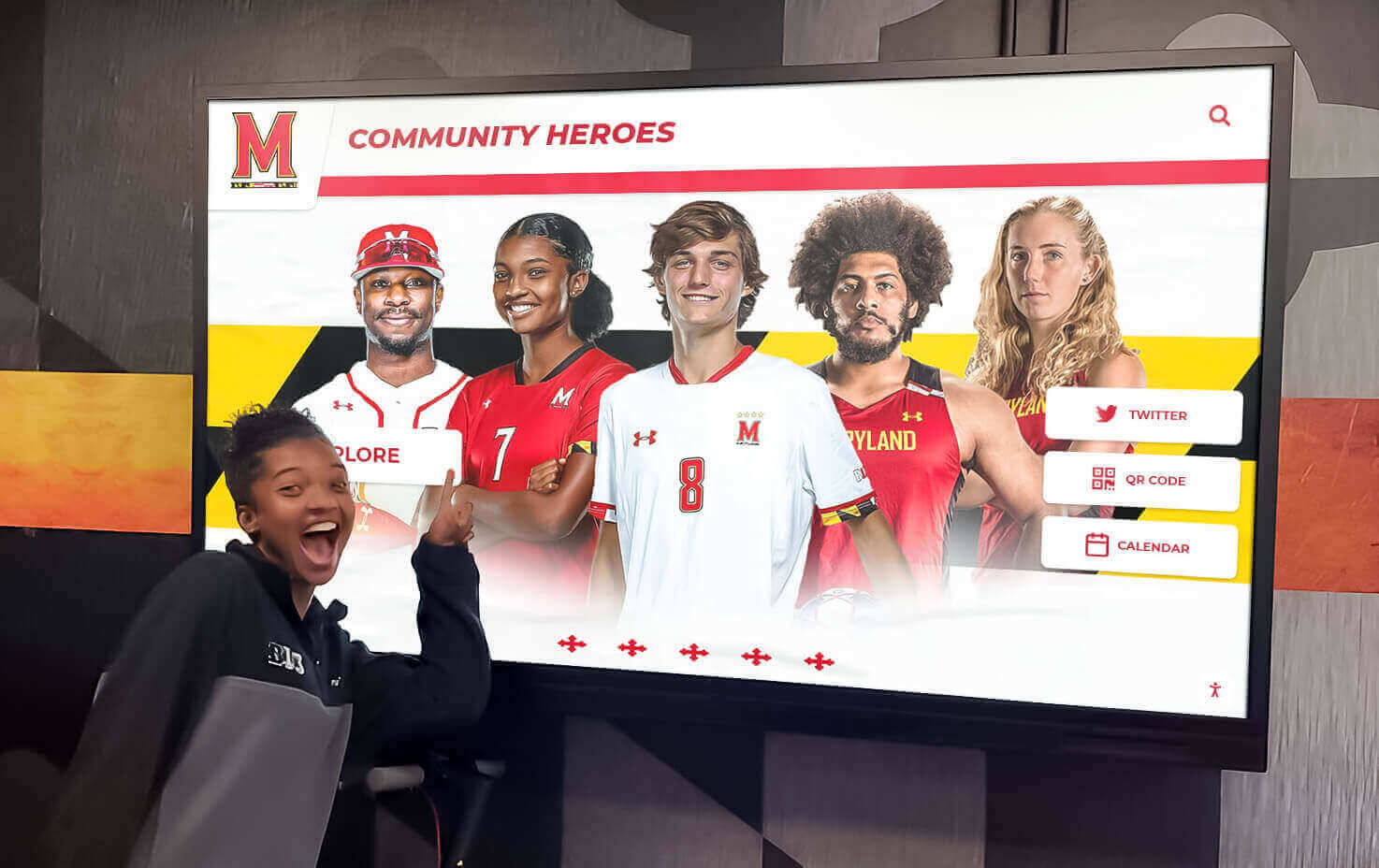
Measuring Success and Demonstrating Return on Investment
Understanding recognition programs’ return on investment requires tracking specific metrics demonstrating financial value, engagement patterns, and advancement strategy effectiveness, proving program worth to institutional leadership and justifying continued support.
Engagement and Usage Analytics
For digital recognition, interactive platforms provide detailed analytics impossible with traditional approaches, offering insights into actual user behavior rather than assumptions about what engages audiences.
Visitor Interaction Metrics:
Comprehensive tracking includes unique visitor counts showing total individuals engaging with recognition displays, session duration measuring average engagement time (benchmark: 6-9 minutes for well-designed collegiate displays versus 30-60 seconds for static walls representing 10x engagement improvement), pages per session indicating exploration depth and content discovery patterns, return visitor rates showing percentage returning on subsequent campus visits demonstrating sustained interest rather than one-time curiosity, peak usage patterns revealing times of highest engagement informing event scheduling and promotional timing, and search query analysis showing what visitors search for revealing content gaps, popular donors, or discovery challenges requiring improved navigation.
Content Performance Analysis:
Track which content resonates most powerfully including most-viewed profiles showing individual donors receiving greatest attention and why their stories engage audiences, category popularity revealing recognition tiers, class years, academic programs, or athletic teams receiving most exploration, video engagement measuring completion rates for video testimonials indicating whether they maintain interest or lose viewers, social sharing volume tracking frequency of recognition shared to social media platforms and which profiles generate organic promotion, and comparative analytics showing physical display versus web-based engagement patterns informing multi-channel strategy development.
Fundraising Outcome Correlations
Ultimate recognition program success appears in broader institutional metrics demonstrating that investment in recognition generates measurable returns through changed alumni giving behavior.
Donor Behavior Impact Measurements:
Track changes in giving patterns following recognition implementation including retention rate improvements comparing retention for recognized versus non-recognized donors (benchmark: 15-30 percentage point improvements representing potentially doubling average donor lifespan), average gift size trends showing year-over-year gift amount comparisons for engaged donors versus control groups (benchmark: 20-30% increases for recognized donors over 3-year periods), upgrade conversion rates measuring percentage of donors moving to higher recognition tiers annually (benchmark: 10-15% versus 4-6% baseline upgrade rates without recognition motivation), time-to-next-gift intervals comparing recognized donors versus non-recognized showing whether recognition shortens giving cycles, and major gift success rates tracking proposal acceptance rates for prospects exposed to recognition during cultivation (benchmark: 25-40% increases in six-figure+ gift commitments).
Return on Investment Calculation Framework:
Calculate recognition ROI through lifetime donor value improvements using the formula:
Average Lifetime Donor Value = (Average Annual Gift × Average Donor Lifespan) + (Probability of Major Gift × Average Major Gift Size)
Recognition programs increase lifetime value through all components simultaneously—higher average annual gifts through peer influence and giving level expectations (20-30% improvements typical), extended donor lifespans via improved retention (retention improvements often double average donor lifespan from 4-5 years to 8-10 years), and increased probability and size of major gifts as donors with strong recognition-driven institutional connections give transformational gifts at 3-4x rates of less-engaged supporters.
Universities implementing comprehensive collegiate donor recognition programs typically report systems paying for themselves within 24-36 months through enhanced giving patterns alone, before accounting for operational efficiencies, stewardship benefits, student recruitment advantages from demonstrating strong alumni support, and institutional reputation enhancements in competitive higher education landscapes.
Best Practices and Common Pitfalls
Universities achieving greatest recognition-driven fundraising success follow proven practices while avoiding common mistakes that diminish effectiveness and waste investment.
Recognition Program Best Practices
Timeliness and Responsiveness: Add new alumni donors to recognition quickly after gifts—within 45-60 days maximum for physical additions, within 2-3 weeks for digital updates. Delayed recognition diminishes psychological satisfaction and can feel like afterthought acknowledgment rather than grateful immediate response. According to donor psychology research, recognition impact degrades approximately 15-20% for each month of delay between gift and acknowledgment, highlighting critical importance of timely recognition processes.
Privacy and Preference Respect: Always honor donor wishes about recognition including anonymous giving options respecting privacy preferences for supporters wanting impact without public acknowledgment, control over information displayed with some donors preferring minimal biographical detail or no gift amount disclosure, recognition decline options for those uncomfortable with public acknowledgment despite major gift size, preferred names, titles, and class year designations spelled exactly as donors specify, separate “in honor of” or “in memory of” recognition options for memorial and tribute gifts, and family name consolidation options when multiple family members prefer collective rather than individual recognition.
Inclusive Recognition Philosophy: Acknowledge diverse forms of support beyond only financial contributions including volunteer leadership serving on boards, campaign committees, or alumni association leadership; in-kind donations of equipment, art, collections, or professional services; planned gifts and estate provisions creating future institutional support; multi-generational family giving celebrating family philanthropic traditions; corporate matching gift programs honoring companies supporting employee giving; and recurring monthly donor programs recognizing sustained small-dollar support often from young alumni. This comprehensive approach builds broad communities of supporters rather than exclusive recognition clubs benefiting only major donors, strengthening institutional culture around philanthropy as community value rather than elite activity.
Common Mistakes to Avoid
Inadequate Planning and Resource Allocation: Launching recognition programs without comprehensive planning leads to problems including unclear recognition criteria creating perceptions of arbitrariness or favoritism, insufficient budget for quality execution undermining donor confidence in institutional stewardship, no plan for ongoing maintenance, updates, and content refreshment allowing recognition to become stale, inadequate staff time allocated for content management resulting in delays and donor frustration, and lack of integration with broader advancement strategies limiting fundraising impact.
Generic, Impersonal Recognition: Simply listing donor names, class years, and gift amounts without stories or context misses opportunities to create emotional connections inspiring continued support and major gift upgrades. Recognition should tell complete stories about alumni donors’ educational experiences, career paths, motivations for giving, institutional connections, family traditions, and impact their gifts enable rather than functioning as transactional acknowledgment lists that could apply to any institution.
Technology Selection Errors: For digital recognition, choosing consumer-grade equipment rather than commercial displays leads to early failures creating poor impressions during donor visits and requiring expensive replacements. Select purpose-built recognition platforms designed specifically for higher education donor acknowledgment rather than adapting generic digital signage systems lacking recognition-specific features, advancement database integration, donor privacy controls, or giving-focused analytics. Working with experienced providers specializing in collegiate environments ensures appropriate hardware selections, professional installation, reliable ongoing support, and systems designed for institutional demands rather than retail or corporate applications.
Launching Without Promotion: Installing excellent recognition without comprehensive promotion to target audiences wastes investment when potential supporters, campus visitors, students, and prospects don’t know it exists or understand its significance. Plan multi-channel launch campaigns engaging alumni through email and social media, campus community through student publications and orientation programs, major gift prospects through exclusive preview events, and broader audiences through media coverage and website features. Sustained visibility efforts through monthly spotlights, event integration, and consistent communications prove essential for maximizing recognition impact ensuring alumni donors feel appropriately honored through visibility their contributions deserve.
Conclusion: Recognition as Strategic Advancement Infrastructure
Collegiate donor walls represent powerful investments in institutional advancement cultures, fundraising effectiveness, and campus community connection. When thoughtfully designed, professionally implemented, and consistently maintained, these programs honor generous supporters while creating lasting benefits across multiple strategic priorities—enhanced donor retention generating compound financial returns over decades, improved giving patterns through peer influence and clear level expectations, stronger alumni engagement supporting volunteerism and institutional advocacy, current student inspiration modeling philanthropic citizenship, institutional reputation benefits demonstrating cultures valuing generosity, and competitive advantages in attracting students and faculty to well-supported institutions.
The most successful approaches balance tradition with innovation, establishing clear criteria and transparent processes while leveraging technology to expand what’s possible in storytelling, engagement, and advancement data analytics. Whether implementing traditional plaques honoring timeless permanence alumni value, cutting-edge digital recognition systems providing dynamic multimedia experiences, or hybrid approaches combining both elements serving diverse preferences, fundamental principles remain constant: meaningful recognition that celebrates generosity authentically, preserves legacy appropriately, strengthens community bonds, and inspires future philanthropy sustaining institutional excellence across generations.
Universities ready to honor alumni donors comprehensively have more sophisticated options than ever before. Modern solutions provide platforms combining intuitive technology, professional implementation services, and ongoing support ensuring recognition success without requiring extensive technical expertise or diverting advancement staff from core fundraising and donor relationship responsibilities. The future of higher education advancement combines emotional power of meaningful recognition with contemporary technology’s capabilities—creating experiences that honor generous supporters appropriately while inspiring the continued philanthropy that sustains academic missions, research enterprises, student support, and institutional aspirations across generations.
Keys to Collegiate Donor Recognition Success:
- Define clear recognition criteria aligned with fundraising strategy, institutional values, and donor expectations
- Budget comprehensively for quality implementation worthy of institutional standards and sustained operations
- Collect rich donor content creating emotional connections and compelling stories beyond names and gift amounts
- Select appropriate recognition formats matching institutional contexts, campus architecture, and diverse alumni preferences
- Promote recognition consistently through multiple channels reaching alumni, students, prospects, and campus communities
- Integrate recognition throughout advancement programming from cultivation through stewardship and campaign management
- Measure engagement outcomes and fundraising correlations enabling continuous improvement and ROI demonstration
- Plan for long-term sustainability with adequate budget, staffing, processes, and leadership commitment
Ready to explore options for your collegiate donor wall program? Whether starting from scratch or enhancing existing displays, modern recognition solutions offer powerful capabilities for celebrating generous alumni while strengthening the bonds connecting past, present, and future members of your academic community—ultimately advancing missions that transform lives through higher education and research that benefits society.
